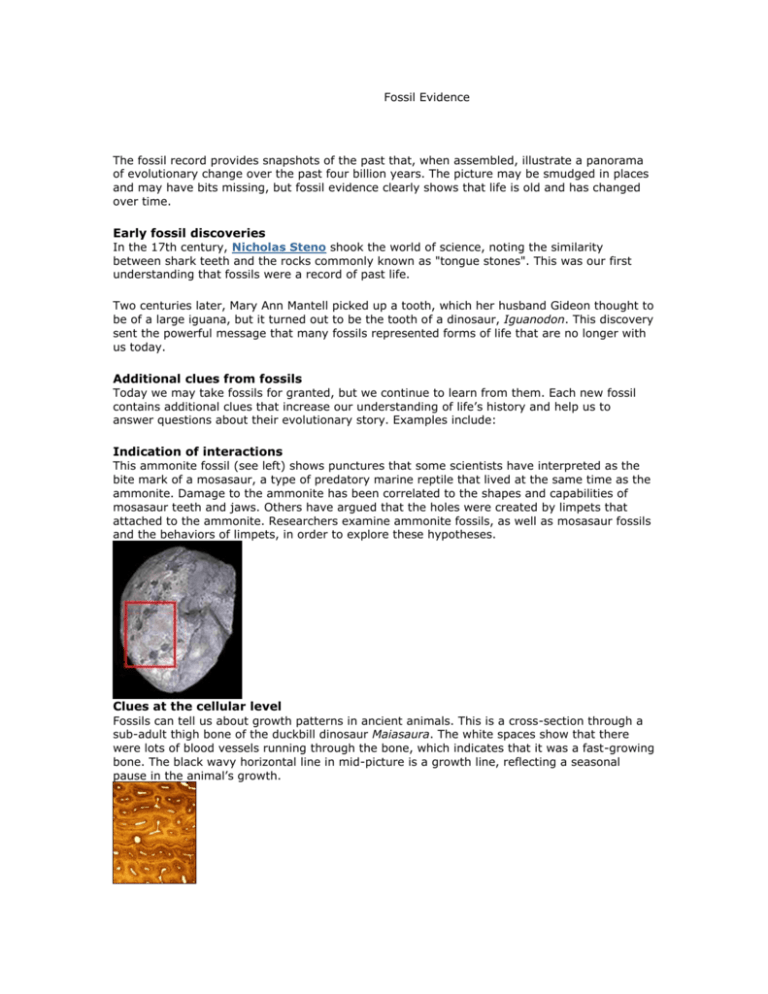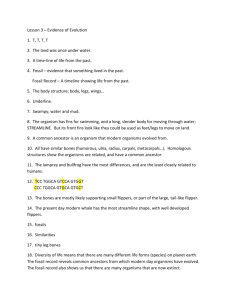Fossil Evidence
advertisement

Fossil Evidence The fossil record provides snapshots of the past that, when assembled, illustrate a panorama of evolutionary change over the past four billion years. The picture may be smudged in places and may have bits missing, but fossil evidence clearly shows that life is old and has changed over time. Early fossil discoveries In the 17th century, Nicholas Steno shook the world of science, noting the similarity between shark teeth and the rocks commonly known as "tongue stones". This was our first understanding that fossils were a record of past life. Two centuries later, Mary Ann Mantell picked up a tooth, which her husband Gideon thought to be of a large iguana, but it turned out to be the tooth of a dinosaur, Iguanodon. This discovery sent the powerful message that many fossils represented forms of life that are no longer with us today. Additional clues from fossils Today we may take fossils for granted, but we continue to learn from them. Each new fossil contains additional clues that increase our understanding of life’s history and help us to answer questions about their evolutionary story. Examples include: Indication of interactions This ammonite fossil (see left) shows punctures that some scientists have interpreted as the bite mark of a mosasaur, a type of predatory marine reptile that lived at the same time as the ammonite. Damage to the ammonite has been correlated to the shapes and capabilities of mosasaur teeth and jaws. Others have argued that the holes were created by limpets that attached to the ammonite. Researchers examine ammonite fossils, as well as mosasaur fossils and the behaviors of limpets, in order to explore these hypotheses. Clues at the cellular level Fossils can tell us about growth patterns in ancient animals. This is a cross-section through a sub-adult thigh bone of the duckbill dinosaur Maiasaura. The white spaces show that there were lots of blood vessels running through the bone, which indicates that it was a fast-growing bone. The black wavy horizontal line in mid-picture is a growth line, reflecting a seasonal pause in the animal’s growth. Nicholas Steno's anatomical drawing of an extant shark (left) and a fossil shark tooth (right). Steno made the leap and declared that the fossil teeth indeed came from the mouths of once-living sharks. http://evolution.berkeley.edu/evosite/lines/Ifossil_ev.shtml Anatomical Evidence Individual organisms contain, within their bodies, abundant evidence of their histories. The existence of these features is best explained by evolution. Several animals, including pigs, cattle, deer, and dogs have reduced, nonfunctional digits, referred to as dewclaws. The foot of the pig has lost digit 1 completely, digits 2 and 5 have been greatly reduced, and only digits 3 and 4 support the body. Evolution best explains such vestigial features. They are the remnants of ancestors with a larger number of functional digits. People (and apes) have chests that are broader than they are deep, with the shoulder blades flat in back. This is because we, like apes, are descended from an ancestor who was able to suspend itself using the upper limbs. On the other hand, monkeys and other quadrupeds have a different form of locomotion. Quadrupeds have narrow, deep chests with shoulder blades on the sides. Hoatzin chicks have claws on their wings, as do some chickens and ostriches. This reflects the fact that bird ancestors had clawed hands. Organisms that are closely related to one another share many anatomical similarities. Sometimes the similarities are conspicuous, as between crocodiles and alligators, but in other cases considerable study is needed for a full appreciation of relationships. Modification of the tetrapod skeleton Whales and hummingbirds have tetrapod skeletons inherited from a common ancestor. Their bodies have been modified and parts have been lost through natural selection, resulting in adaptation to their respective lifestyles over millions of years. On the surface, these animals look very different, but the relationship between them is easy to demonstrate. Except for those bones that have been lost over time, nearly every bone in each corresponds to an equivalent bone in the other. Embryology Evidence In embryology, the developing fetus is studied, and similarities with other organisms are observed. For example, annelids and mollusks are very dissimilar as adults. If, however, the embryo of a ragworm and a whelk are studied, one sees that for much of their development they are remarkably similar. Even the larvae of these two species are very much alike. This suggests that they both belong to a common ancestor. It is not, however, true that a developing organism replays its evolutionary stages as an embryo. There are some similarities with the more conserved regions, but embryonic development is subjected to evolutionary pressures as much as other areas of the life cycle. The analysis of developmental stages of various related species, particularly involving reproduction suggests common descent and supports evolution. Sexual reproduction in both apes and humans, for example, is very similar. Molecular biology also produces evidences supporting evolution. Organisms such as fruit flies have similar gene sequences that are active in specific times during development and these sequences are very similar to sequences in mice and even humans that are activated in similar ways during development. Even in cell biology, at the level of the individuals cell, there is evidence of evolution in that there are many similarities that can be observed when comparing various cells from different organisms. Many structures and pathways within the cell are important for life. The more important and basic to the functioning of the tissues in which cells contribute, the more likely it will be conserved. For example, the DNA code (the genetic material in the cell) is the very similar in comparing DNA from different organisms. In molecular biology, the concept of a molecular clock has been suggested. The molecular clock related to the average rate in which a gene (or a specific sequence of DNA that encodes a protein) or protein evolves. Genes evolve at different rates the proteins that they encode. This is because gene mutations often do not change the protein. But due to mutations, the genetic sequence of a species changes over time. The more closely related the two species, the more likely they will have similar sequences of their genetic material, or DNA sequence. The molecular clock provides relationships between organisms and helps identify the point of divergence between the two species. Pseudogenes are genes that are part of an organisms DNA but that have evolved to no longer have important functions. Pseudogenes, therefore, represent another line of evidence supporting evolution, which is based on concepts derived from molecular genetics. Perhaps the most persuasive argument that favors evolution is the fossil record. Paleontology (the study of fossils) provides a record that many species that are extinct. By techniques such as carbon dating and studying the placement of fossils within the ground, an age can be assigned to the fossil. By placing fossils together based on their ages, a gradual change in form can be identified, which can be carefully compared to species that currently exist. Although fossil records are incomplete, with many intermediate species missing, careful analysis of habitat, environmental factors at various timepoints, characteristics of extinct species, and characteristics of species that currently exist supports theories of evolution and natural selection. Biochemistry Evidence Biochemistry also reveals similarities between organisms of different species. For example, the metabolism of vastly different organisms is based on the same complex biochemical compounds. The protein cytochrome c, essential for aerobic respiration, is one such universal compound. The universality of cytochrome c is evidence that all aerobic organisms probably descended from a common ancestor that used this compound for respiration. Certain blood proteins found in almost all organisms give additional evidence that these organisms descended form a common ancestor. Such biochemical compounds, including cytochrome c and blood proteins, are so complex it is unlikely that almost identical compounds would have evolved independently in widely different organisms. Further studies of cytochrome c in different species reveal variations in the amino acid sequence of this molecule. For example, the cytochrome c of monkeys and cows is more similar than the cytochrome c of monkeys and fish. Such similarities and differences suggest that monkeys and cows ate more closely related than are monkeys and fish. Scientists have similarly compared the biochemistry of universal blood proteins. Their studies reveal evidence of degrees of relatedness between different species. This evidence implies that some species share a more recent common ancestor than other species do. From such evidence scientists have inferred the evolutionary relationships between different species of organisms. The similarities described above are not the only ones scientists have noticed among organisms of different species. The image to the left shows that embryos of certain species develop almost identically, especially in the early stages. Such physical similarities indicate that there are genetic similarities between the organisms. These similarities can be considered evidence that the organisms shown probably descended from a common ancestor. The similarities between living species-- in ancestry, in homologous and vestigial structures, in embryological development, and in biochemical compounds-- all could be explained as extremely remarkable coincidences. However, a far more probable explanation of these similarities is that species have arisen by descent and modification from more ancient forms. Additionally, the fossil record contributes compelling evidence that species have changed over time. The fossil evidence and evidence from living organisms strongly suggest that species evolve.







